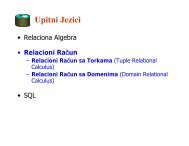You also want an ePaper? Increase the reach of your titles
YUMPU automatically turns print PDFs into web optimized ePapers that Google loves.
m. Recovery process optimization of distal radius fractures. The distal radius fracture is one<br />
of the most common injures of the upper limbs. The largest numbe<strong>rs</strong> of these injuries are<br />
treated non-operatively (orthopedic reduction and cast immobilization for 4-6 weeks). The<br />
complications are frequent after this serious injury. The median nerve runs right across the<br />
site of a Colles´s fracture and may be compressed by the bruising and bleeding around it.<br />
Median nerve damage in this region results in weakened thenar and thumb muscle, as well as<br />
sensitive disorde<strong>rs</strong> of the hand. EMG must be performed in accordance to standard<br />
procedure, which is unconformable for a patient. The aim of measurements with this new<br />
technology is detecting the damage and evaluating the recovery process.<br />
n. Detection of negative, neutral, or positive effects of new drugs, currently under test by the<br />
drugs administration procedures. Changes on neuromuscular system can be detected in<br />
different controlled conditions .This use case also includes screening of new active<br />
substances (potentially new commercial drugs) for dose-effect influence on the human<br />
locomotor system.<br />
o. Diagnostics of post-operative condition and reduced functionality of the locomotor system<br />
(e.g., following aesthetic and corrective surgery…). The changes are a consequence of<br />
temporary partial or total immobilization. Intensity of biomechanical and physiological<br />
changes will be studied on different case sensitive muscle groups. Study of RTP<br />
(recommended treatment procedures) and total recovery is also included into this use<br />
case.<br />
p. Low back pain management. Low back pain is among the most frequent conditions in our<br />
clinical practice. High percentage of asymmetry, in average population, origins from their<br />
working place conditions or from improper body posture. Most of the examples of lower<br />
back pain origins from erector spinae lateral asymmetry which can influence muscles and<br />
joints of lower extremities. From our experiences we can affirm that most of the examples of<br />
lower back pain origins from erector spinae lateral asymmetry. Pathologic changes in<br />
muscles usually demonstrate in higher muscle tonus, which causes change in activation level<br />
of one or both sides of erector spinae. The results will help us to calculate the professional<br />
risk of low back pain developing by some occupations and to develop more efficient<br />
diagnostic for low back injure level index.<br />
q. Evaluation of the integration level of implants and orthotics and the efficiency of their<br />
support or correction of musculoskeletal deformities and/or abnormalities of the human body.<br />
Monitoring the influence on local muscle tissue influenced by implants and orthosisand<br />
optimisation of ergonomics and study of RTP<br />
Also, a number of screening studies will be performed:<br />
r. Insight into the possible impacts of environment pollution on muscle state and potentials.<br />
Study of RTP.


![Proposal - start [kondor.etf.rs]](https://img.yumpu.com/3715277/10/500x640/proposal-start-kondoretfrs.jpg)


![Anytime, Anywhere Learning Behavior Using a ... - start [kondor.etf.rs]](https://img.yumpu.com/3996703/1/184x260/anytime-anywhere-learning-behavior-using-a-start-kondoretfrs.jpg?quality=85)